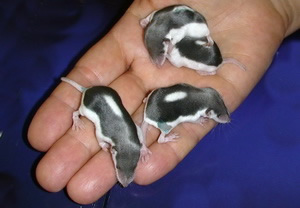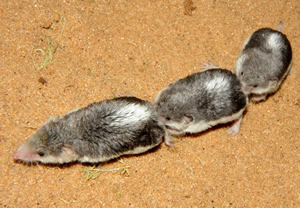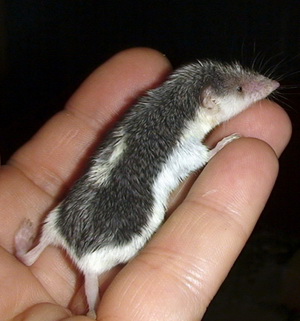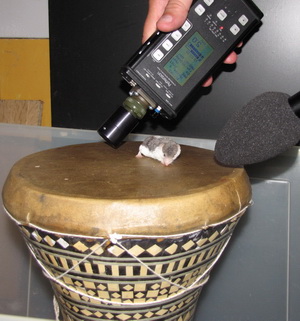|
|
|
PIEBALD SHREW (Diplomesodon pulchellum)

Study Site: Moscow Zoo (Moscow, Russia).
Dates: Since 2011 onwards.
Participants:Volodin Ilya, Volodina Elena, Zaytseva Alexandra.
Collaborators: Ilchenko Olga (Moscow Zoo, Moscow, Russia), Anastasia Chebotareva (Moscow State Pedagogical University and Moscow Zoo, Moscow, Russia).
Popular papers: <Priroda>. |
|
In mammalian ontogenesis, increasing sizes of sound-producing structures (lungs, and larynx with vocal folds) and of vocal tract (pharynx, oral and nasal cavities) follow the increase in body size and mass. A general rule from physics suggests that the larger oscillating structures provide the lower oscillating frequency. So, it should be reasonable to expect, that in larger adults calls will be longer and/or higher-intensive compared to calls of smaller pups (as the adults have more lung capacity), with the lower fundamental frequency (due to longer vocal folds) and lower formants (due to longer vocal tracts).
While this rule is complied for many mammalian species, some exclusions have been observed. For example, the fundamental frequency does not change at maturate compared to juvenile individuals in sea otters and five (!) species of ground squirrels – speckled, yellow, Richardson’s, russet and erythrogenys ground squirrels (see the project Ground squirrels). The reasons of such “declines” from the common rule, resulting from simple sound physics are still poorly understood, but the explaining hypotheses, although speculative, but always intriguing.
The postnatal ontogenesis of insectivores is very fast, with pups becoming undistinguishable from adults approximately to the age of 20 days, and at 30–40 days the young are capable of breeding. Accordingly, the acoustic communication system develops under time, on the background of fast changes in morphology and social interrelationships in maturing animals. In addition, for some insectivores, the use of audible and ultrasound for echolocation, and sensitivity to seismic waves has been reported.
The project has a few research focuses:
- Describing the structural variation and call types in adults and pups
- The ontogenetic changes of call structures along ontogenesis; the relating them to changes in morphological traits and body mass
- Searching for ultrasonic sound or clicks and of vibration-generated airborne sounds, describing their structures and probable functions.
  Sounds in the Gallery. Sounds in the Gallery.
|
 |
 |
 |
 |
| © Photo by Olga Ilchenko. |
|
Papers:
- Zaytseva A.S., Volodin I.A., Mason M.J., Frey R., Fritsch G., Ilchenko O.G., Volodina E.V. Vocal development during postnatal growth and ear morphology in a shrew that generates seismic vibrations, Diplomesodon pulchellum // Behavioural Processes, 2015, V. 118, P. 130–141. 219.pdf
- Volodin I.A., Zaytseva A.S., Ilchenko O.G., Volodina E.V. Small mammals ignore common rules: A comparison of vocal repertoires and the acoustics between pup and adult piebald shrews Diplomesodon pulchellum // Ethology, 2015, V. 121, N 2, P. 103-115. 215.pdf
- Zaytseva A.S., Vakhrusheva G.V., Ilchenko O.G., Volodin I.A. Postnatal development of piebald shrews (Diplomesodon pulchellum, Insectivora, Soricidae) in captivity // Zoologicheskii Zhurnal, 2013, V. 92, ¹ 12, P. 1463-1474. (available in Russian) 196.pdf
-
Volodin I.A., Zaytseva A.S., Ilchenko O.G., Volodina E.V., Chebotareva A.L. Measuring airborne components of seismic body vibrations in a Middle-Asian sand-dwelling Insectivora species, the piebald shrew (Diplomesodon pulchellum) // Journal of Experimental Biology, 2012, v. 215, N 16, p. 2849-2852. 190.pdf
|
|

